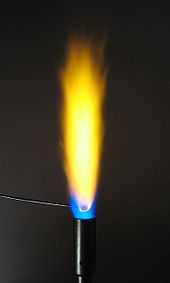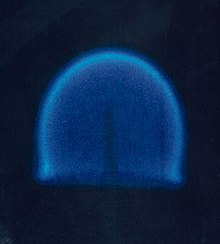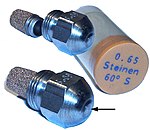For other uses, see Injector (disambiguation) and Ejector (disambiguation).

 Diagram of a typical modern ejector.
Diagram of a typical modern ejector.
An injector, ejector, steam ejector, steam injector,eductor-jet pump or thermocompressor is a type o fpump that uses the Venturi effect of a converging-diverging nozzle to convert the pressure energy of a motive fluid to velocity energy which creates a low pressure zone that draws in and entrains a suction fluid. After passing through the throat of the injector, the mixed fluid expands and the velocity is reduced which results in recompressing the mixed fluids by converting velocity energy back into pressure energy. The motive fluid may be a liquid, steam or any other gas. The entrained suction fluid may be a gas, a liquid, a slurry, or a dust-laden gas stream.
The adjacent diagram depicts a typical modern ejector. It consists of a motive fluid inlet nozzle and a converging-diverging outlet nozzle. Water, air, steam, or any other fluid at high pressure provides the motive force at the inlet.
The Venturi effect, a particular case of Bernoulli's principle, applies to the operation of this device. Fluid under high pressure is converted into a high-velocity jet at the throat of the convergent-divergent nozzle which creates a low pressure at that point. The low pressure draws the suction fluid into the convergent-divergent nozzle where it mixes with the motive fluid.
In essence, the pressure energy of the inlet motive fluid is converted to kinetic energy in the form of velocity head at the throat of the convergent-divergent nozzle. As the mixed fluid then expands in the divergent diffuser, the kinetic energy is converted back to pressure energy at the diffuser outlet in accordance with Bernoulli's principle. There are very few steam locomotives still in operation today other than as tourist attractions. However, when steam locomotives were in use many years ago, injectors were used to pump water into the locomotive's steam-producing boiler and some of the steam was used as the injector's motive fluid. Such "steam injectors" took advantage of the latent heat released by the resulting condensation of the motive steam.
Depending on the specific application, an injector takes the form of an eductor-jet pump, a water eductor, a vacuum ejector, asteam-jet ejector, or an aspirator.

 Diagram of a typical modern ejector.
Diagram of a typical modern ejector.An injector, ejector, steam ejector, steam injector,eductor-jet pump or thermocompressor is a type o fpump that uses the Venturi effect of a converging-diverging nozzle to convert the pressure energy of a motive fluid to velocity energy which creates a low pressure zone that draws in and entrains a suction fluid. After passing through the throat of the injector, the mixed fluid expands and the velocity is reduced which results in recompressing the mixed fluids by converting velocity energy back into pressure energy. The motive fluid may be a liquid, steam or any other gas. The entrained suction fluid may be a gas, a liquid, a slurry, or a dust-laden gas stream.
The adjacent diagram depicts a typical modern ejector. It consists of a motive fluid inlet nozzle and a converging-diverging outlet nozzle. Water, air, steam, or any other fluid at high pressure provides the motive force at the inlet.
The Venturi effect, a particular case of Bernoulli's principle, applies to the operation of this device. Fluid under high pressure is converted into a high-velocity jet at the throat of the convergent-divergent nozzle which creates a low pressure at that point. The low pressure draws the suction fluid into the convergent-divergent nozzle where it mixes with the motive fluid.
In essence, the pressure energy of the inlet motive fluid is converted to kinetic energy in the form of velocity head at the throat of the convergent-divergent nozzle. As the mixed fluid then expands in the divergent diffuser, the kinetic energy is converted back to pressure energy at the diffuser outlet in accordance with Bernoulli's principle. There are very few steam locomotives still in operation today other than as tourist attractions. However, when steam locomotives were in use many years ago, injectors were used to pump water into the locomotive's steam-producing boiler and some of the steam was used as the injector's motive fluid. Such "steam injectors" took advantage of the latent heat released by the resulting condensation of the motive steam.
Depending on the specific application, an injector takes the form of an eductor-jet pump, a water eductor, a vacuum ejector, asteam-jet ejector, or an aspirator.
Key design parameters
The compression ratio of the injector, , is defined as ratio of the injectors's outlet pressure
, is defined as ratio of the injectors's outlet pressure  to the inlet pressure of the suction fluid
to the inlet pressure of the suction fluid  .
.
The entrainment ratio of the injector, , is defined as the amount of motive fluid
, is defined as the amount of motive fluid  (in kg/hr) required to entrain and compress a given amount
(in kg/hr) required to entrain and compress a given amount  (in kg/hr) of suction fluid..
(in kg/hr) of suction fluid..
The compression ratio and the entrainment ratio are key parameters in designing an injector or ejector.
The compression ratio of the injector,
 , is defined as ratio of the injectors's outlet pressure
, is defined as ratio of the injectors's outlet pressure  to the inlet pressure of the suction fluid
to the inlet pressure of the suction fluid  .
.The entrainment ratio of the injector,
 , is defined as the amount of motive fluid
, is defined as the amount of motive fluid  (in kg/hr) required to entrain and compress a given amount
(in kg/hr) required to entrain and compress a given amount  (in kg/hr) of suction fluid..
(in kg/hr) of suction fluid..The compression ratio and the entrainment ratio are key parameters in designing an injector or ejector.
History

 A- Steam from boiler, B- Needle valve, C- Needle valve handle, D- Steam and water combine, E- Water feed, F- Combining cone, G- Delivery nozzle and cone, H- delivery chamber and pipe, K- Check valve, L- Overflow
A- Steam from boiler, B- Needle valve, C- Needle valve handle, D- Steam and water combine, E- Water feed, F- Combining cone, G- Delivery nozzle and cone, H- delivery chamber and pipe, K- Check valve, L- Overflow

 A more modern drawing of the injector used in steam locomotives.
A more modern drawing of the injector used in steam locomotives.

 Steam injector of a steam locomotive boiler.
Steam injector of a steam locomotive boiler.
The injector was invented by a Frenchman, Henri Giffard in 1858and patented in the United Kingdomby Messrs Sharp Stewart & Co. of Glasgow. Motive force was provided at the inlet by a suitable high-pressure fluid.

 A- Steam from boiler, B- Needle valve, C- Needle valve handle, D- Steam and water combine, E- Water feed, F- Combining cone, G- Delivery nozzle and cone, H- delivery chamber and pipe, K- Check valve, L- Overflow
A- Steam from boiler, B- Needle valve, C- Needle valve handle, D- Steam and water combine, E- Water feed, F- Combining cone, G- Delivery nozzle and cone, H- delivery chamber and pipe, K- Check valve, L- Overflow
 A more modern drawing of the injector used in steam locomotives.
A more modern drawing of the injector used in steam locomotives.
 Steam injector of a steam locomotive boiler.
Steam injector of a steam locomotive boiler.The injector was invented by a Frenchman, Henri Giffard in 1858and patented in the United Kingdomby Messrs Sharp Stewart & Co. of Glasgow. Motive force was provided at the inlet by a suitable high-pressure fluid.
Feedwater injectors
The injector was originally used in the boilers of steam locomotives for injecting or pumping the boiler feedwater into the boiler. The injector consisted of a body containing a series of three or more nozzles, "cones" or "tubes". The motive steam passed through a nozzle that reduced its pressure below atmospheric and increased the steam velocity. Fresh water was entrained by the steam jet, and both steam and water entered a convergent "combining cone" which mixed them thoroughly so that the water condensed the steam. The condensate mixture then entered a divergent "delivery cone" which slowed down the jet, and thus built up the pressure to above that of the boiler. An overflow was required for excess steam or water to discharge, especially during starting. There was at least one check valve between the exit of the injector and the boiler to prevent back flow, and usually a valve to prevent air being sucked in at the overflow.
After some initial scepticism resulting from the unfamiliar and superficially paradoxical mode of operation, the injector was widely adopted as an alternative to mechanical pumps in steam-driven locomotives. The key to understanding how it works is to appreciate that steam, having a much lower density than water, attains a much higher velocity than water would do in flowing from a high pressure to a low pressure through the steam cone. When this jet of steam meets cold water in the combining cone, the principle of conservation of momentum applies. The steam is condensed by mixing with the cold water but the flow of water is accelerated by absorbing the momentum of the high velocity water molecules condensed from the steam. Since the steam, in condensing, gives up its latent heat energy, this causes the temperature of the resultant jet of water to be raised. When this accelerated jet of water passes through the delivery cone, it is capable to developing a much higher pressure than that of the original supply of steam and is thus able to overcome the boiler pressure at the check valve, thereby allowing water to enter the boiler. Furthermore, the addition of heat to the flow of water lessens the effect of the injected water in cooling the water in the boiler compared to the case of cold water injected via a mechanical feed pump. Most of the heat energy in the condensed steam is therefore returned to the boiler, increasing the thermal efficiency of the process. Injectors were therefore simple and reliable and also thermally efficient.
Efficiency was further improved by the development of a multi-stage injector which was powered not by live steam from the boiler but by exhaust steam from the cylinders, thereby making use of the residual energy in the exhaust steam which would otherwise have gone to waste.
Injectors could be troublesome under certain running conditions, when vibration caused the combined steam and water jet to "knock off". Originally the injector had to be restarted by careful manipulation of the steam and water controls, and the distraction caused by a malfunctioning injector was largely responsible for the 1913 Ais Gill rail accident. Later injectors were designed to automatically restart on sensing the collapse in vacuum from the steam jet, for example with a spring-loaded delivery cone.
The injector was originally used in the boilers of steam locomotives for injecting or pumping the boiler feedwater into the boiler. The injector consisted of a body containing a series of three or more nozzles, "cones" or "tubes". The motive steam passed through a nozzle that reduced its pressure below atmospheric and increased the steam velocity. Fresh water was entrained by the steam jet, and both steam and water entered a convergent "combining cone" which mixed them thoroughly so that the water condensed the steam. The condensate mixture then entered a divergent "delivery cone" which slowed down the jet, and thus built up the pressure to above that of the boiler. An overflow was required for excess steam or water to discharge, especially during starting. There was at least one check valve between the exit of the injector and the boiler to prevent back flow, and usually a valve to prevent air being sucked in at the overflow.
After some initial scepticism resulting from the unfamiliar and superficially paradoxical mode of operation, the injector was widely adopted as an alternative to mechanical pumps in steam-driven locomotives. The key to understanding how it works is to appreciate that steam, having a much lower density than water, attains a much higher velocity than water would do in flowing from a high pressure to a low pressure through the steam cone. When this jet of steam meets cold water in the combining cone, the principle of conservation of momentum applies. The steam is condensed by mixing with the cold water but the flow of water is accelerated by absorbing the momentum of the high velocity water molecules condensed from the steam. Since the steam, in condensing, gives up its latent heat energy, this causes the temperature of the resultant jet of water to be raised. When this accelerated jet of water passes through the delivery cone, it is capable to developing a much higher pressure than that of the original supply of steam and is thus able to overcome the boiler pressure at the check valve, thereby allowing water to enter the boiler. Furthermore, the addition of heat to the flow of water lessens the effect of the injected water in cooling the water in the boiler compared to the case of cold water injected via a mechanical feed pump. Most of the heat energy in the condensed steam is therefore returned to the boiler, increasing the thermal efficiency of the process. Injectors were therefore simple and reliable and also thermally efficient.
Efficiency was further improved by the development of a multi-stage injector which was powered not by live steam from the boiler but by exhaust steam from the cylinders, thereby making use of the residual energy in the exhaust steam which would otherwise have gone to waste.
Injectors could be troublesome under certain running conditions, when vibration caused the combined steam and water jet to "knock off". Originally the injector had to be restarted by careful manipulation of the steam and water controls, and the distraction caused by a malfunctioning injector was largely responsible for the 1913 Ais Gill rail accident. Later injectors were designed to automatically restart on sensing the collapse in vacuum from the steam jet, for example with a spring-loaded delivery cone.
Vacuum ejectors
An additional use for the injector technology was in vacuum ejectors in continuous train braking systems, which were made compulsory in the UK by the Regulation of Railways Act 1889. A vacuum ejector uses steam pressure to draw air out of the vacuum pipe and reservoirs of continuous train brake. Steam locomotives, with a ready source of steam, found ejector technology ideal with its rugged simplicity and lack of moving parts. Vacuum brakes have been superseded by air brakes in modern trains, which use pumps, as diesel and electric locomotives no longer have a suitable working fluid for vacuum ejectors.
An additional use for the injector technology was in vacuum ejectors in continuous train braking systems, which were made compulsory in the UK by the Regulation of Railways Act 1889. A vacuum ejector uses steam pressure to draw air out of the vacuum pipe and reservoirs of continuous train brake. Steam locomotives, with a ready source of steam, found ejector technology ideal with its rugged simplicity and lack of moving parts. Vacuum brakes have been superseded by air brakes in modern trains, which use pumps, as diesel and electric locomotives no longer have a suitable working fluid for vacuum ejectors.
Modern uses
The use of injectors (or ejectors) in various industrial applications has become quite common due to their relative simplicity and adaptability. For example:
To inject chemicals into the boiler drums of small, stationary, low pressure boilers. In large, high-pressure modern boilers, usage of injectors for chemical dosing is not possible due to their limited outlet pressures.
In thermal power stations, they are used for the removal of the boiler bottom ash, the removal of fly ash from the hoppers of theelectrostatic precipitators used to remove that ash from the boiler flue gas, and for creating a vacuum pressure in steam turbine exhaust condensers.
Jet pumps have been used in boiling water nuclear reactors to circulate the coolant fluid.
For use in producing a vacuum pressure in steam jet cooling systems.
For the bulk handling of grains or other granular or powdered materials.
The construction industry uses them for pumping turbid water and slurries.
Some aircraft (mostly earlier designs) use an ejector attached to the fuselage to provide vacuum for gyroscopic instruments such as an attitude indicator.
aspirators are vacuum pumps based on the same operating principle and are used in laboratories to create a partial vacuum and for medical use in suction of mucus or bodily fluids.
Water eductors are water pumps used for dredging silt and panning for gold, they're used because they can handle quite well the highly abrasive mixtures that are pumped
The use of injectors (or ejectors) in various industrial applications has become quite common due to their relative simplicity and adaptability. For example:
To inject chemicals into the boiler drums of small, stationary, low pressure boilers. In large, high-pressure modern boilers, usage of injectors for chemical dosing is not possible due to their limited outlet pressures.
In thermal power stations, they are used for the removal of the boiler bottom ash, the removal of fly ash from the hoppers of theelectrostatic precipitators used to remove that ash from the boiler flue gas, and for creating a vacuum pressure in steam turbine exhaust condensers.
Jet pumps have been used in boiling water nuclear reactors to circulate the coolant fluid.
For use in producing a vacuum pressure in steam jet cooling systems.
For the bulk handling of grains or other granular or powdered materials.
The construction industry uses them for pumping turbid water and slurries.
Some aircraft (mostly earlier designs) use an ejector attached to the fuselage to provide vacuum for gyroscopic instruments such as an attitude indicator.
aspirators are vacuum pumps based on the same operating principle and are used in laboratories to create a partial vacuum and for medical use in suction of mucus or bodily fluids.
Water eductors are water pumps used for dredging silt and panning for gold, they're used because they can handle quite well the highly abrasive mixtures that are pumped



.jpg)




 Fig. 3.7.10
Fig. 3.7.10 Fig. 3.7.9
Fig. 3.7.9


 Fig. 3.7.4
Fig. 3.7.4


.jpg)



 This section may contain original research. Please improve it by verifying the claims made and adding references. Statements consisting only of original research may be removed. More details may be available on the talk page. (September 2009)
This section may contain original research. Please improve it by verifying the claims made and adding references. Statements consisting only of original research may be removed. More details may be available on the talk page. (September 2009)















